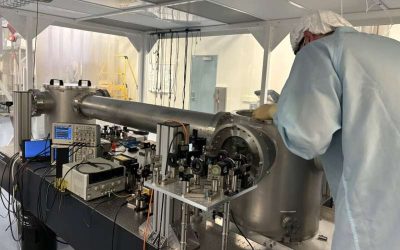The LUX ZEPLIN (LZ) Dark Matter experiment is a large research effort involving over 200 scientists and engineers at 40 institutions worldwide. Its key objective is to search for weakly interacting massive particles (WIMPs) by analyzing data collected by the LZ...
Astronomy
Search results for dark photon leptonic decays manage to exclude new regions
Dark photons are hypothetical particles that resemble light particles (i.e., photons), but interact weakly with normal matter, which would make them impossible or very difficult to detect using conventional experimental methods. These particles are dark matter...
First results from the Axion Dark-Matter Birefringent Cavity experiment establish a new technique for axion search
Researchers at MIT recently published the first results of an experiment aimed at searching for axion dark matter by probing the axion-induced birefringence of electromagnetic waves. While these findings, published in Physical Review Letters, did not...
Exploring the possibility of probing fundamental spacetime symmetries via gravitational wave memory
As predicted by the theory of general relativity, the passage of gravitational waves can leave a measurable change in the relative positions of objects. This physical phenomenon, known as gravitational wave memory, could potentially be leveraged to study both...
A three-step mechanism explaining ultraviolet-induced CO desorption from CO ice
The desorption of CO ice induced by ultraviolet (UV) radiation is a phenomenon that occurs in some cold parts of the universe, which has often also been replicated in laboratory settings. While this phenomenon is now well-documented, the molecular mechanisms...
New constraints on the presence of ultralight dark matter in the Milky Way
Dark matter, composed of particles that do not reflect, emit or absorb light, is predicted to make up most of the matter in the universe. Its lack of interactions with light, however, prevents its direct detection using conventional experimental methods.
Study sets new constraints on the kinetic mixing of hidden photon dark matter
As dark matter is comprised of particles that do not absorb, emit or reflect light, it cannot be observed directly with the methods used to observe conventional matter. In recent years, astrophysicists worldwide have thus been devising methods that could help to...
Research group unveils properties of cosmic-ray sulfur and the composition of other primary cosmic rays
Charged cosmic rays, high-energy clusters of particles moving through space, were first described in 1912 by physicist Victor Hess. Since their discovery, they have been the topic of numerous astrophysics studies aimed at better understanding their origin,...
Could dark photon dark matter be directly detected using radio telescopes?
Dark matter, matter in the universe that does not emit, absorb or reflect light, cannot be directly detected using conventional telescopes or other imaging technologies. Astrophysicists have thus been trying to identify alternative methods to detect dark matter for...
Could quantum fluctuations in the early universe enhance the creation of massive galaxy clusters?
Astrophysicists have been trying to understand the formation of cosmological objects and phenomena in the universe for decades. Past theoretical studies suggest that quantum fluctuations in the early universe, known as primordial quantum diffusion, could have given...










